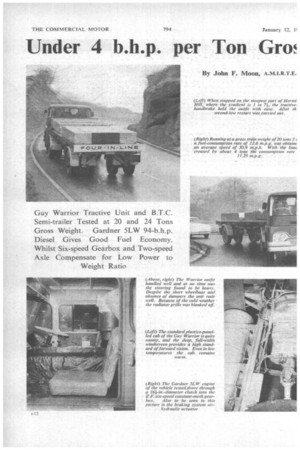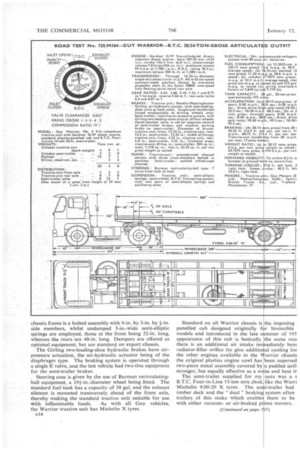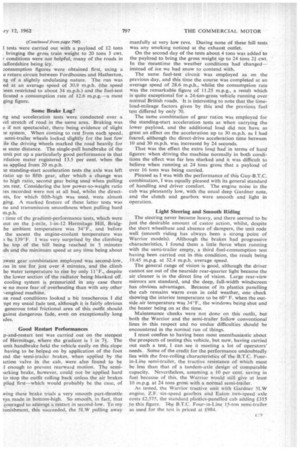Under 4 b.h.p. per Ton Grco
Page 68

Page 69

Page 70

Page 75

If you've noticed an error in this article please click here to report it so we can fix it.
By John F. Moon, A.M.I.R.T.E.
RMALLY, I can never be accused of advocating tder-powering any size of vehicle, but occasionally lave to eat,my words. For example, if anyone had I me that I could actually enjoy driving a 24-tonriculated outfit powered by an engine developing i.h.p. I would have inclined to have become abusive: recently, that is. Two days spent testing a Guy coupled to a B.T.C. semi-trailer have now conle that sometimes it is possible to get away with t 4 b.h.p. per ton gross weight, though I still feel t so it is only the combination of a Gardner engine Eaton two-speed axle wbich makes this at all
is, this Warrior articulated outfit with Gardner gine was able to carry a payload of well over with an exceptional degree of fuel economy and a gly fair turn of speed. Needless to say, this outfit exactly at the top of its class so far as acceleration :erned, but six main-gearbox ratios and the twoe combined to make acceleration better than would ted and gave an entirely adequate gradient perforFurthermore, the top speed of nearly 45 m.p.h. achieved quite easily on a normal undulating main
;uy Warrior tractive unit was originally intended ation at 20 tons gross train weight, but recently its manufacturers have sanctioned its use at 24 tons, at the same time making the Gardner 5LW unit Available, this 7-litre five-cylindered engine developing 94 b.h.p. at 1,700 r.p.m. and 300 lb.-ft. torque at 1,300 r.p.m.
As Gardner engines have not previously been used in Warrior models the installation and attendant transmission are more akin to those of the larger Invincible range. Indeed, the engine carries a hydraulically operated 161-in.diameter flexible-centre clutch as used behind the Gardner 6LX, whilst the gearbox adopted for use with the 5LW is a Z.F. six-speed constant-mesh unit with overdrive top gear.
The engine-gearbox assembly is initiated in the frame Invincible-fashion also, making use of two rubber sandwiches in compression and shear at the front of the engine and cylindrical rubber bushes in shear carried in a special clutch housing. Another sign Of Invincible influence lies in the location of the large oil-bath air cleaner inside the cab, the cleaner being bolted to the back panel and drawing air through a hole in that panel.
In other respects this latest addition to the Warrior range follows previous practice for these models. An Eaton 18800 two-speed axle is standard equipment and this has ratios of 6.5 and 8.87 to 1, whilst the front axle has an H-section bed with 21-in.-diameter stub axles carried on parallel kingpins which have phosphor-bronze bushes. The chassis frame is a bolted assembly with 9-in. by 3-in. by +-in. side members, whilst undamped 3-in.-wide semi-elliptic springs are employed, those at the front being 52-in, long, whereas the rears are 48-in, long. Dampers are offered as optional equipment, but are standard an export chassis.
The Girling two-leading-shoe hydraulic brakes have airpressure actuation, the air-hydraulic actuator being of the diaphragm type. The braking system is operated through a single E valve, and the test vehicle had two-line equipment for the semi-trailer brakes.
Steering ease is given by the use of Burman recirculatingball equipment, a 191-in,-diameter wheel being fitted. The standard fuel tank has a capacity of 38 gal. and the exhaust silencer is mounted transversely ahead of the front axle, thereby making the standard tractive unit suitable for use with inflammable loads. As with all Guy vehicles, the Warrior tractive unit has Michelin X tyres. El 4 Standard on all Warrior chassis is the imposing panelled cab designed originally for Invincible models and introduced in the late summer of 195 appearance of this cab is basically the same exa there is an additional air intake immediately bent radiator-filler orifice (to give additional cooling for the other engines available in the Warrior chassis the original plastics engine cowl has been supersed two-piece metal assembly covered by a padded quill stronger, but equally effective as a noise and heat in The semi-trailer supplied for my tests was a s B.T.C. Four-in-Line 15-ton unit shod, like the Warni Michelin 9.00-20 X tyres, The semi-trailer had timber deck and the " dual " braking system often trailers of this make which enables them to be with either vacuumor air-braked prime movers. l tests were carried out with a payload of 12 tons bringing the gross train weight to 20 tons 3 cwt. r conditions were not helpful, many of the roads in affordshire being icy.
onsumption figures were obtained first, using a e return circuit between Fordhouses and Hatherton, rig of a slightly undulating nature. The run was eel at an average speed of 30.9 m.p.h. (the speed Deen restricted to about 34 m.p.h.) and the fuel-test heated a consumption rate of 12.6 m.p.g.—a most ging figure.
Some Brake Lag?
ng and acceleration tests were conducted over a vel stretch of road in the same area. Braking was e if not spectacular, there being evidence of slight le system. When coming to rest from each speed, semi-trailer wheels locked slightly for the last few ile the driving wheels marked the road heavily for Le same distance. The single-pull handbrake of the unit put up a particularly good performance in that relation meter registered 13.5 per cent. when the as applied from 20 m.p.h.
le standing-start acceleration tests the axle was left ratio up to fifth gear, after which a change was to high ratio, second gear being used when pulling am rest. Considering the low power-to-weight ratio iris recorded were not at all had, whilst the directsts, for which fifth-high was used, were almost ging. A marked feature of these latter tests was ne and transmission smoothness when pulling hard m.p.h.
time of the gradient-performance tests, which were out on the 1-mile, 1-in-12 Hermitage Hill, Bridghe ambient temperature was 34°F., and before the ascent the engine-coolant temperature was 3 be 139°F. I was very surprised by the climbing he top of the hill being reached in 5 minutes Ids and the minimum speed at any time being about Dwest gear combination employed was second-low, ias in use for just over 4 minutes, and the climb he water temperature to rise by only 11°F., despite the lower section of the radiator being blanked off. cooling system is pressurized in any case there ie no more fear of overheating than with any other --engined machine.
cse road conditions looked a bit treacherous I did Tint my usual fade test, although it is fairly obvious generous total frictional area of this outfit should gainst dangerous fade, even on exceptionally long ides.
Good Restart Performances p-and-restart test was carried out on the steepest of Hermitage, where the gradient is I in 71. The unit handbrake held the vehicle easily on this slope having to be helped on by application of the foot ind the semi-trailer brakes, when applied by the iction valve in the cab, were also found to he LI enough to prevent rearward motion. The semierking brake, however, could not be applied hard to stop the outfit rolling back unless the air brakes plied first—which would probably be the case, of
wing these brake trials a very smooth part-throttle vas made in bottom-high. So smooth, in fact, that couraged to attempt a restart in second-low. To my tonishment, this succeeded, the 5LW pulling away manfully at very low revs. During none of these hill tests was any smoking noticed at the exhaust outlet.
On the second day of the tests about 4 tans was added to the payload to bring the gross weight up to 24 tons 21 cwt. In the meantime the weather conditions had changed— instead of ice we had snow to contend with.
The same fuel-test circuit was employed as on the previous day, and this time the course was completed at an average speed of 28.6 m.p.h., whilst the consumption rate was the remarkable figure of 11.25 m.p.g., a result which is quite exceptional for a 24-ton-gross vehicle running over normal British roads. It is interesting to note that the timeload-mileage factors given by this and the previous fuel test differed by only 70.
The same combination of gear ratios was employed for the standing-start acceleration tests as when carrying the lower payload, and the additional load did not have as great an effect on the acceleration up to 30 m.p.h. as I had feared, although the direct-drive acceleration time between 10 and 30 m.p.h. was increased by 24 seconds.
That was the effect the extra load had in terms of hard figures: when driving the machine normally in both conditions the effect was far less Marked and it was difficult to believe when running at 24 tons gross that a payload of over 16 tons was being carried.
Pleased as I was with the performance of this Guy-B.T.C. combination, I was equally pleased with its general standard of handling and driver comfort. The engine noise in the cab was pleasantly low, with the usual deep Gardner note, and the clutch and gearbox were smooth and light in operation.
Light Steering and Smooth Riding The steering never became heavy, and there seemed to be just the desirable amount of castor action, whilst, despite the short wheelbase and absence of dampers, the unit rode well (smooth riding has always been a strong point of Warrior models). Although the brakes had progressive characteristics, I found them a little fierce when running with the semi-trailer empty, a third fuel-consumption test having been_ carried out in this condition, the result being 19.45 m.p.g. at 32.4 m.p.h. average speed.
The general range of vision is good, although the driver cannot see out of the nearside rear-quarter light because the air cleaner is in the direct line of vision. Large rear-view mirrors are standard, and the deep, full-width windscreen• has obvious advantages. Because of its plastics panelling the cab remains warm even in cold weather, one cheek showing the interior temperature to be 60° F. when the outside air temperature was 34°F.. the windows being shut and the heater being on at the time.
Maintenance checks were not done on this outfit, but both the Warrior and the semi-trailer follow conventional lines in this respect and no undue difficulties should be encountered in the normal run of things.
I must confess to having been most unenthusiastic about the prospects of testing this vehicle, but now, having carried out such a test, I can see it meeting a lot of operators' needs. Some of the credit for the performance undoubtedly lies with the free-rolling characteristics of the•B.T.C. Fourin-Line semi-trailer, the tractive resistance of which must be less than that of a tandem-axle design of comparable capacity. Nevertheless, assuming a 10 per cent. saving in fuel because of this, the Warrior would still give at least 10 m.p.g. at 24 tons gross with a normal semi-trailer.
As tested, the Warrior tractive unit with Gardner 5LW engine. Z.F. 'six-speed gearbox and Eaton two-speed axle costs £2,575, the standard plastics-panelled cab adding £315 to this figure. The B.T.C. Four-in-Line 15-ton semi-trailer as used for the test is priced at £984.








































































































































